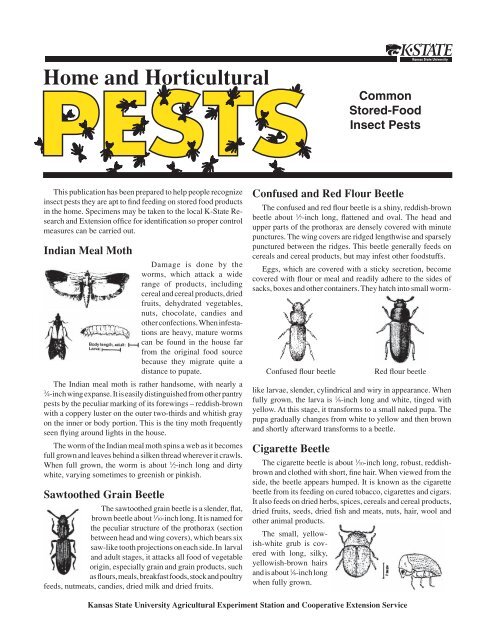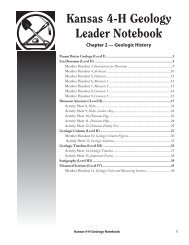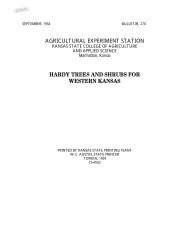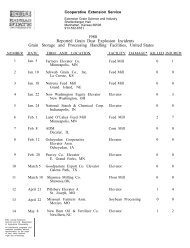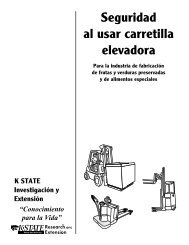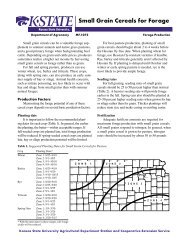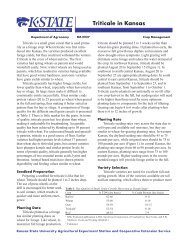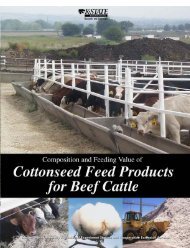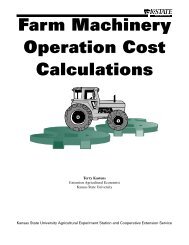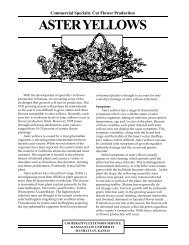MF2271 Common Stored-Food Insect Pests - K-State Research and ...
MF2271 Common Stored-Food Insect Pests - K-State Research and ...
MF2271 Common Stored-Food Insect Pests - K-State Research and ...
You also want an ePaper? Increase the reach of your titles
YUMPU automatically turns print PDFs into web optimized ePapers that Google loves.
Home <strong>and</strong> Horticultural<br />
This publication has been prepared to help people recognize<br />
insect pests they are apt to find feeding on stored food products<br />
in the home. Specimens may be taken to the local K-<strong>State</strong> <strong>Research</strong><br />
<strong>and</strong> Extension office for identification so proper control<br />
measures can be carried out.<br />
Indian Meal Moth<br />
Damage is done by the<br />
worms, which attack a wide<br />
range of products, including<br />
cereal <strong>and</strong> cereal products, dried<br />
fruits, dehydrated vegetables,<br />
nuts, chocolate, c<strong>and</strong>ies <strong>and</strong><br />
other confections. When infestations<br />
are heavy, mature worms<br />
can be found in the house far<br />
from the original food source<br />
because they migrate quite a<br />
distance to pupate.<br />
The Indian meal moth is rather h<strong>and</strong>some, with nearly a<br />
3 ⁄4-inch wing expanse. It is easily distinguished from other pantry<br />
pests by the peculiar marking of its forewings – reddish-brown<br />
with a coppery luster on the outer two-thirds <strong>and</strong> whitish gray<br />
on the inner or body portion. This is the tiny moth frequently<br />
seen flying around lights in the house.<br />
The worm of the Indian meal moth spins a web as it becomes<br />
full grown <strong>and</strong> leaves behind a silken thread wherever it crawls.<br />
When full grown, the worm is about 1 ⁄2-inch long <strong>and</strong> dirty<br />
white, varying sometimes to greenish or pinkish.<br />
Sawtoothed Grain Beetle<br />
The sawtoothed grain beetle is a slender, flat,<br />
brown beetle about 1 ⁄10-inch long. It is named for<br />
the peculiar structure of the prothorax (section<br />
between head <strong>and</strong> wing covers), which bears six<br />
saw-like tooth projections on each side. In larval<br />
<strong>and</strong> adult stages, it attacks all food of vegetable<br />
origin, especially grain <strong>and</strong> grain products, such<br />
as flours, meals, breakfast foods, stock <strong>and</strong> poultry<br />
feeds, nutmeats, c<strong>and</strong>ies, dried milk <strong>and</strong> dried fruits.<br />
<strong>Common</strong><br />
<strong>Stored</strong>-<strong>Food</strong><br />
<strong>Insect</strong> <strong>Pests</strong><br />
Confused <strong>and</strong> Red Flour Beetle<br />
The confused <strong>and</strong> red flour beetle is a shiny, reddish-brown<br />
beetle about 1 ⁄7-inch long, flattened <strong>and</strong> oval. The head <strong>and</strong><br />
upper parts of the prothorax are densely covered with minute<br />
punctures. The wing covers are ridged lengthwise <strong>and</strong> sparsely<br />
punctured between the ridges. This beetle generally feeds on<br />
cereals <strong>and</strong> cereal products, but may infest other foodstuffs.<br />
Eggs, which are covered with a sticky secretion, become<br />
covered with flour or meal <strong>and</strong> readily adhere to the sides of<br />
sacks, boxes <strong>and</strong> other containers. They hatch into small worm-<br />
Confused flour beetle Red flour beetle<br />
like larvae, slender, cylindrical <strong>and</strong> wiry in appearance. When<br />
fully grown, the larva is 1 ⁄6-inch long <strong>and</strong> white, tinged with<br />
yellow. At this stage, it transforms to a small naked pupa. The<br />
pupa gradually changes from white to yellow <strong>and</strong> then brown<br />
<strong>and</strong> shortly afterward transforms to a beetle.<br />
Cigarette Beetle<br />
The cigarette beetle is about 1 ⁄10-inch long, robust, reddishbrown<br />
<strong>and</strong> clothed with short, fine hair. When viewed from the<br />
side, the beetle appears humped. It is known as the cigarette<br />
beetle from its feeding on cured tobacco, cigarettes <strong>and</strong> cigars.<br />
It also feeds on dried herbs, spices, cereals <strong>and</strong> cereal products,<br />
dried fruits, seeds, dried fish <strong>and</strong> meats, nuts, hair, wool <strong>and</strong><br />
other animal products.<br />
The small, yellowish-white<br />
grub is covered<br />
with long, silky,<br />
yellowish-brown hairs<br />
<strong>and</strong> is about 1 ⁄6-inch long<br />
when fully grown.<br />
Kansas <strong>State</strong> University Agricultural Experiment Station <strong>and</strong> Cooperative Extension Service
The pupae are within a closed cell composed of small particles<br />
of the food substance cemented together with a secretion<br />
of the larvae.<br />
Drugstore Beetle<br />
The drugstore beetle is<br />
about 1 ⁄10-inch long, cylindrical<br />
<strong>and</strong> uniformly light<br />
brown. Its body is covered<br />
with a fine, silky down, <strong>and</strong><br />
it has fairly long antennae<br />
or feelers. This insect is<br />
known as the drugstore<br />
beetle because of its habit<br />
of feeding on almost all drugs found in pharmacies. It is a very<br />
general feeder, attacking a great variety of stored foods, seeds,<br />
pet foods, spices <strong>and</strong> pastry mixes, <strong>and</strong> has been said to “eat<br />
anything except cast iron.”<br />
Cabinet Beetles<br />
Cabinet beetles are small beetles (sometimes referred to<br />
as carpet beetles) that prefer stored foods. The larval stage of<br />
these beetles does most of the damage. Full-grown larvae are<br />
about 3 ⁄8-inch long, with a tapered body. Dark clumps of long<br />
hairs are common on the tapered end.<br />
Cockroaches<br />
Cockroaches are easily identified by their brownish, flattened<br />
body <strong>and</strong> long antennae. They prefer to move about in<br />
darkness <strong>and</strong> thus are not often seen in the daytime. Their flat<br />
body allows them to hide in very narrow places such as under<br />
baseboards <strong>and</strong> kitchen appliances. Depending on the species,<br />
cockroaches can occur in any part or the house as long as food<br />
<strong>and</strong> water is available.<br />
Fruit Flies<br />
As the name implies, fruit flies are pests of fruits <strong>and</strong> some<br />
vegetables <strong>and</strong> can develop rapidly in warm weather. Fruit that<br />
is beginning to decay will attract them, <strong>and</strong> the best control is<br />
to get rid of the food source. The tiny flies are about 1 ⁄8-inch<br />
long <strong>and</strong> have red eyes. The larvae is a tiny maggot.<br />
George E. Lippert<br />
Crop Protection Specialist, Southeast<br />
Br<strong>and</strong> names appearing in this publication are for product identification purposes only. No endorsement is intended,<br />
nor is criticism implied of similar products not mentioned.<br />
Publications from Kansas <strong>State</strong> University are available on the World Wide Web at: http://www.oznet.ksu.edu<br />
Contents of this publication may be freely reproduced for educational purposes. All other rights reserved. In each case, credit<br />
George E. Lippert, <strong>Common</strong> <strong>Stored</strong>-<strong>Food</strong> <strong>Insect</strong> <strong>Pests</strong>, Kansas <strong>State</strong> University, January 1998.<br />
Kansas <strong>State</strong> University Agricultural Experiment Station <strong>and</strong> Cooperative Extension Service<br />
MF-2271 January 1998<br />
It is the policy of Kansas <strong>State</strong> University Agricultural Experiment Station <strong>and</strong> Cooperative Extension Service that all persons shall have equal opportunity<br />
<strong>and</strong> access to its educational programs, services, activities, <strong>and</strong> materials without regard to race, color, religion, national origin, sex, age or disability. Kansas<br />
<strong>State</strong> University is an equal opportunity organization. Issued in furtherance of Cooperative Extension Work, Acts of May 8 <strong>and</strong> June 30, 1914, as amended.<br />
Kansas <strong>State</strong> University, County Extension Councils, Extension Districts, <strong>and</strong> United <strong>State</strong>s Department of Agriculture Cooperating, Marc A. Johnson,<br />
Director.


